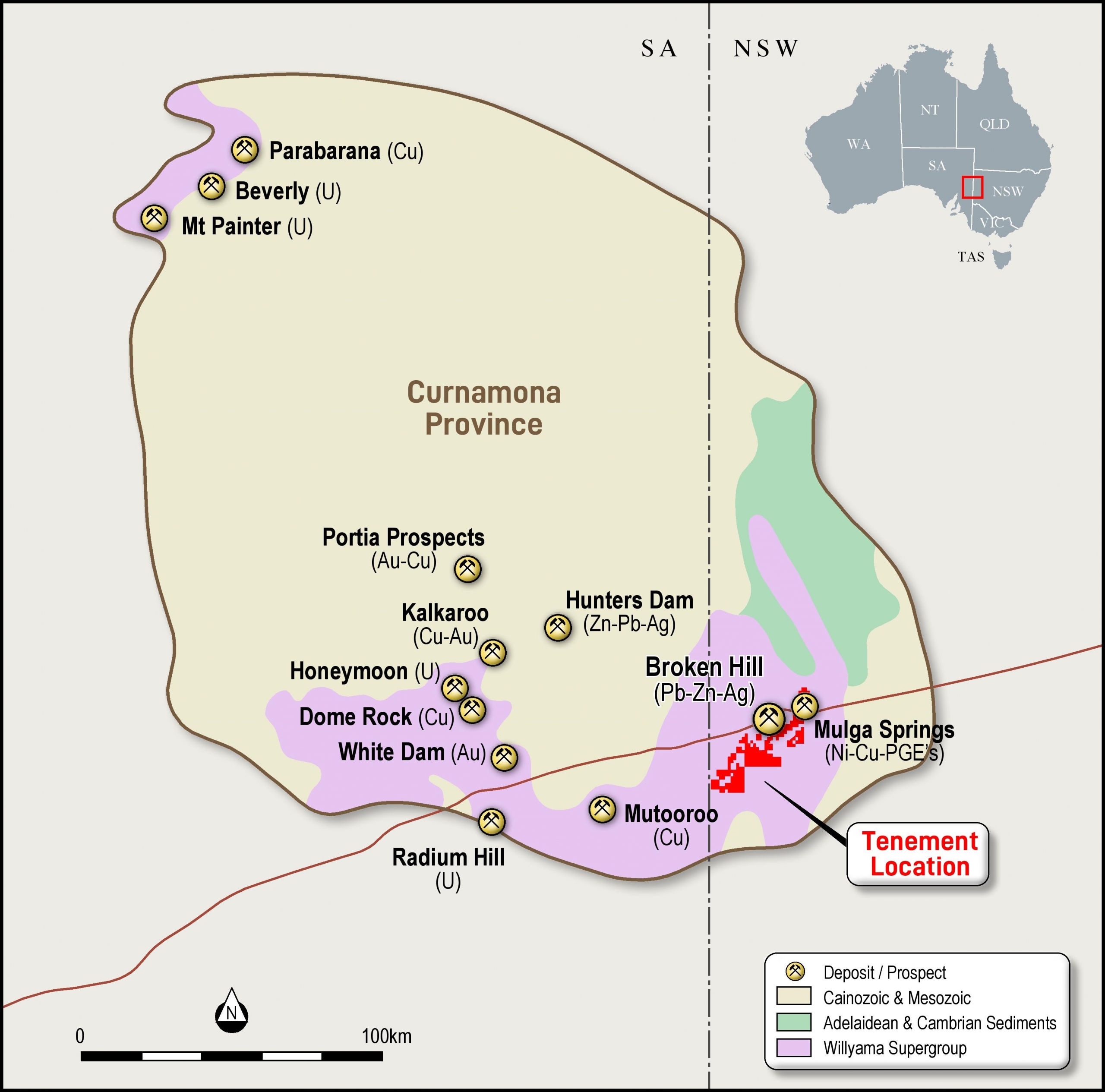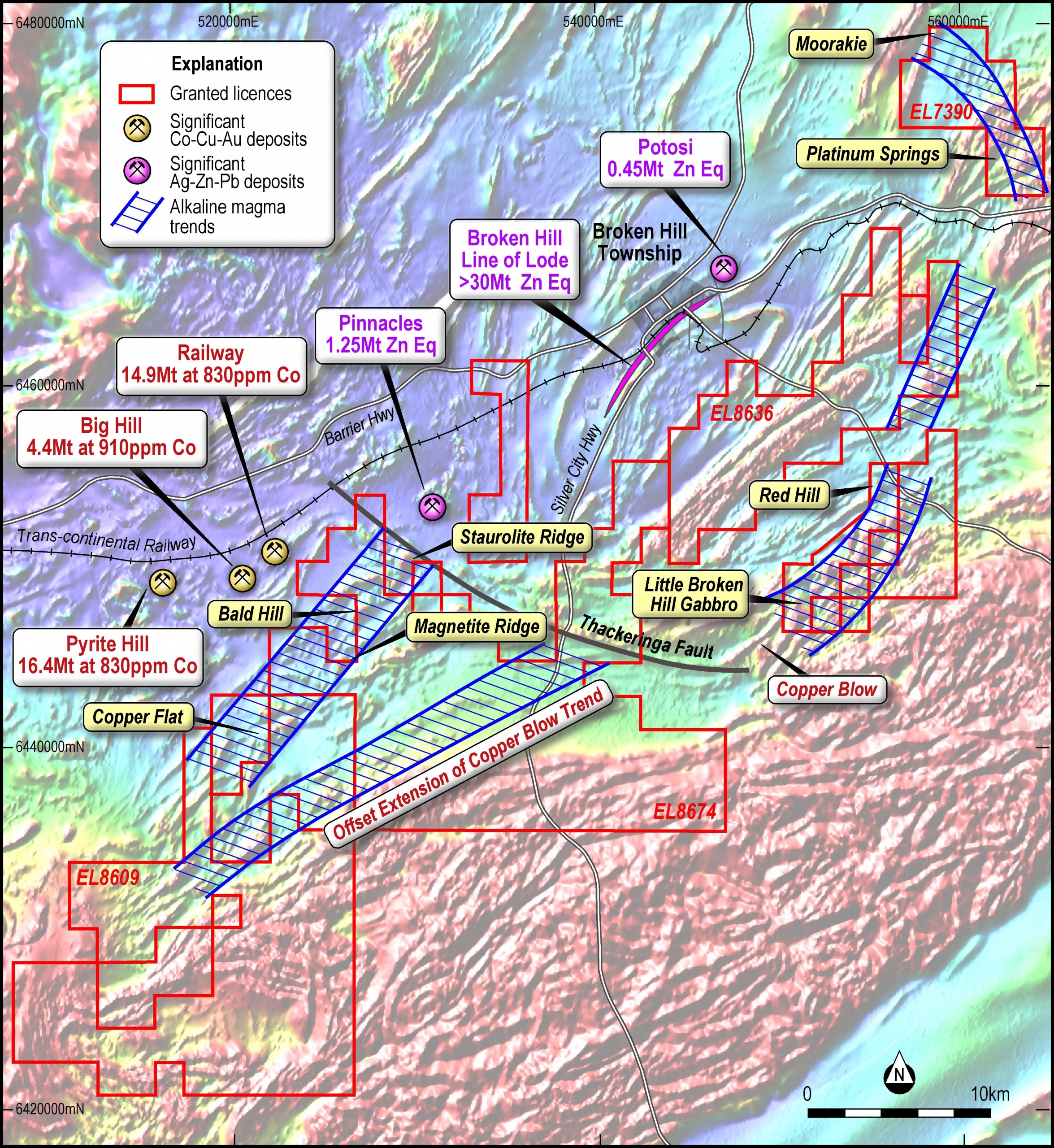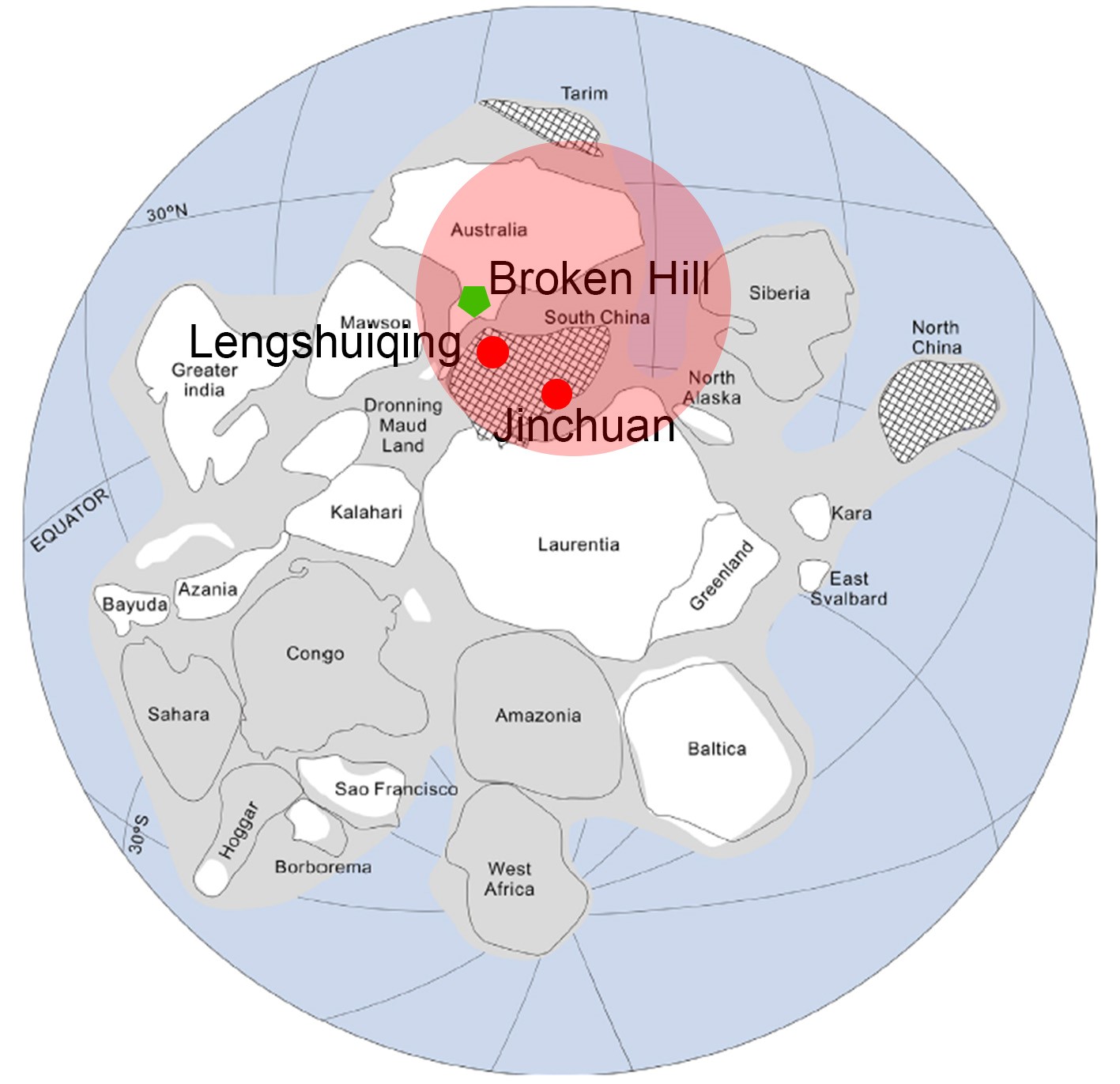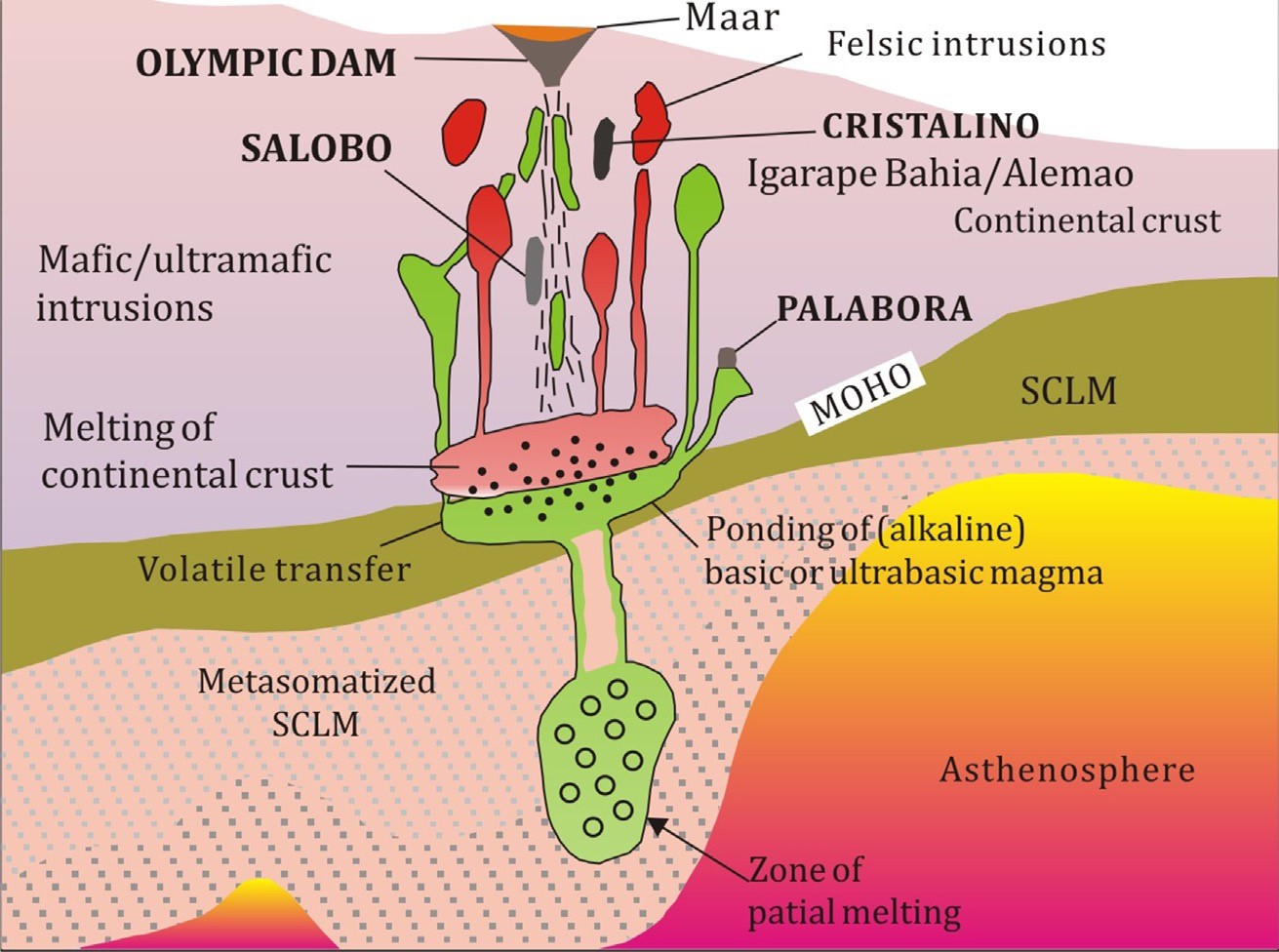Broken Hill
The Broken Hill Ni-Cu-PGE Project is located 20 km east of the World Class Broken Hill silver-lead-zinc mine in New South Wales, and consists of 100% owned seven Exploration Licences covering 816 sq km in the south east part of the richly mineralised Curnamona Province (Figures 1 and 2).
The project area contains several tens of strike kilometres of mafic-ultramafic sills, dykes and stocks that contain gossans and fresh outcrops with very high-grade PGE’s, nickel, copper, gold and silver mineralisation (Figure 2).
Impact has completed a significant amount of in-house research on these rocks which has lead to a new geodynamic framework for the Broken Hill area.

Figure 1. Location of the Broken Hill Ni-Cu-PGE Project

Figure 2. Location of alkaline magma trends in the Broken Hill area. The Little Broken Hill to Moorkaie Trend contains rocks of potassic ultramafic to alkaline gabbro composition. The Copper Flat to Staurolite Ridge Trend contains rocks of alkaline gabbro to carbonatite composition. An offset of the Copper Blow Trend is interpreted to the south of the Thackeringa Fault Zone.
A new Geodynamic Framework for Broken Hill
A new geodynamic framework for exploration has been identified following the widespread recognition of alkaline magmatic rocks throughout the Company’s ground holdings and the wider Broken Hill area.
Impact has shown that the very high grade palladium and platinum mineralisation at the Red Hill, Platinum Springs and Moorkaie Prospects and the Iron Oxide Copper Gold (IOCG) mineralisation at the Copper Blow Prospect (ASX:SCI) are hosted by and related to alkaline magmatic rocks (ASX Announcement 13th December 2018).

Figure 3. Position of the proposed mantle plume head (red circle) responsible for the breakup of Rodinia showing the location of Broken Hill in relation to the Jinchuan and Lengshuiqing Ni-Cu-Co-PGE deposits at about 800 million years ago (after Huang et al., 2015).
New work by Impact, done in conjunction with Independent Expert Emeritus Professor Ken Collerson of the University of Queensland, has now demonstrated that the alkaline rocks are related to a deep seated mantle plume that was related to the breakup of the Rodinia supercontinent about 800 million years ago.
At this time, Broken Hill and the surrounding Curnamona Province were positioned close to the world class nickel-copper-PGE deposit of Jinchuan (>500 Mt at 1.2% nickel, 0.7% copper and 0.4 g/t total PGE) and the significant Lengquisheng deposit (>30 Mt at 0.8% nickel and 0.3% copper (unknown PGE), which after breakup drifted to become part of China (Figure 4).
In addition Impact has identified the first recorded example in the Broken Hill region of rocks of carbonatite composition formed by the fractionation of the alkaline magmas. This is significant given that such rocks are host to major copper-gold-cobalt PGE-Rare Earth Element (REE) deposits around the world.
These major deposits formed as an integral part of processes associated with the mantle plume and accordingly confirm that the Broken Hill area and Impact’s ground in particular have the correct geodynamic setting to host a range of deposit styles related to this geodynamic setting including major nickel-copper-PGE, IOCG and carbonatite-related deposits.
Implications for Exploration
The new geodynamic framework shows that the high grade nickel-copper-PGE mineralisation at Broken Hill was formed in a similar place to, at the same time as, and by the same processes that led to the formation of the Jinchuan deposit in China, one of the world’s largest magmatic sulphide deposits (Figure 4).
The confirmation of widespread alkaline intrusions across the Broken Hill region confirms there are at least several very deep seated structures in the area that have tapped the core-mantle boundary at about 800 million years ago and released mineralised magmas and fluids into the upper crust.
The structures facilitated an upwelling mantle plume related to the breakup of the supercontinent Rodinia between 830 – 720 Ma when Rodinia was over the Pacific Superplume.
This new geodynamic framework has allowed the Broken Hill area to be viewed with “fresh eyes” in terms of its prospectivity for a wide range of mineral deposits formed later in the geological history than the major silver-lead-zinc deposit Broken Hill itself. A major target generation exercise based on this work has been completed. A major drill programme was completed at the end of 2020 to test some of the key targets with many assay results awaited.
These results add to previous work by Impact which has identified numerous areas for follow up work for high grade deposits of nickel-copper-platinum group metals (PGM)-cobalt both along the Rockwell to Little Broken Hill Trend and along the entire length of a mafic-ultramafic complex interpreted from regional magnetic and gravity data to extend over about 40 km of strike north east to the Moorkai Trend (Figure 2 and ASX Announcements 3rd May 2017 and 13th December 2018).
Very high grade primary nickel-copper-PGM-gold mineralisation has been discovered along this complex by Impact at both the Red Hill Prospect and also the Platinum Springs Prospect (Figure 2).
At Red Hill exceptional grades have been returned from drilling including a stand out intercept in vein hosted sulphide of:
1.2 metres at 10.4 g/t platinum, 10.9 g/t gold, 254 g/t (9.5 ounces) palladium, 7.4% nickel,
1.8% copper, 19 g/t silver and 0.5% cobalt (ASX Announcement 26th October 2015).
At Platinum Springs drilling returned a very high grade intercept in magmatic massive sulphide of
0.6 metres at 11.5 g/t platinum, 25.6 g/t palladium, 1.4 g/t gold, 7.6% copper, 7.4% nickel and
44.3 g/t silver (cobalt not analysed) (ASX Announcements 3rd February 2016 and 31st March 2016).
Both the Rockwell-Little Broken Hill Trend and the Moorkai Trend have been very poorly explored and many targets remain to be followed up.
For example, at Rockwell a coherent near-surface geochemical anomaly one kilometre long and
150 metres wide has been defined in shallow 2 metre deep auger drill holes along the north western margin of the complex with results of up to 0.1% nickel, 0.1% copper and 0.5 g/t PGM over a one metre thick intercept. There has been no drilling at depth.
Along the Moorkai Trend only Platinum Springs has been explored in detail. Exceptional high grade rock chip samples have been returned from numerous prospects between the Platinum Springs and Moorkai Prospects, a distance of about 9 km along the Moorkai Trend (ASX Announcement 13th December 2018).

Figure 4. Model for IOCG Deposits from Groves and Santosh 2015.
It is evident that considerable scope exists to discover a significant nickel-copper-PGM-cobalt deposit within Impact’s Broken Hill project area.
In addition, it has been shown that alkaline magmas are the deep seated parental magmas to many world-class Iron Oxide Copper Gold Deposits (Figure 3). Impact interprets all of its data, in particular the association of high grade gold-copper with the high grade PGE mineralisation, to indicate the unusual mafic-ultramafic rocks at Broken Hill to be parental magmas for IOCG style mineralisation throughout the region.
This is an important exploration breakthrough for the company and comes at a time of record prices for palladium (currently ~US$2,000/oz which is higher than gold). Exploration at Broken Hill will be reinvigorated as part of the 2019 field season.



